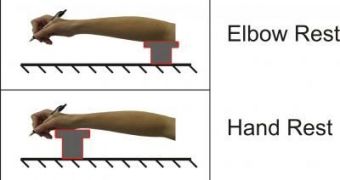As most of you who had at least some connection with using a scalpel, a brush, a pencil or some other tool will know, doing very precise work over prolonged periods of time is exhausting. Artists, including painters and sketch designers, surgeons and other workers have been complaining about this for a long time, and now their calls are finally being answered. A team of engineers from the University of Utah has recently announced the development of a new computer-controlled, motorized hand and arm support, which the team says can be used to precisely control scalpels, brushes and tools, over larger areas than currently possible, and potentially with less fatigue.
“We've invented a new device – the Active Handrest – that's useful for aiding people in performing precision tasks with their hands such as surgery, painting, electronics repair or other tasks that require precise control of the fingertips,” explains UU assistant professor of mechanical engineering, William Provancher. The expert, a member of the team that developed the instrument, says that he and colleagues may start a spin-off company to capitalize on the new technology. A patent for their system is already pending, and the group plans to go to work soon.
The system itself could be used in touch-feedback devices, for producing more advanced robotic surgery equipment, to create art, and to refurbish electronic devices. “The Active Handrest would benefit surgeons and other medical personnel, artists, machinists, workers performing pick-and-place tasks, or anyone requiring dexterous control of tools,” Provancher adds. Full details of the new device will be presented later this month, on March 25, at the Institute of Electrical and Electronics Engineers' Haptics Symposium, which will be held in Waltham, Massachusetts.
“In contrast, the Active Handrest provides ergonomic support and increased precision, but allows the user to maintain complete control of the tool. Furthermore, the Active Handrest can be used with any tool. For force control, the device senses how you are leaning on the wrist rest. If you push forward a little bit, the handrest will move forward in response,” Provancher says. University of Utah mechanical engineering doctoral students Mark Fehlberg and Brian Gleeson, and Levi Leishman, a summer undergraduate researcher, also contributed to the work. The investigation was funded with grant money secured from the US National Science Foundation (NSF).

 14 DAY TRIAL //
14 DAY TRIAL //